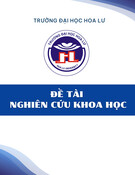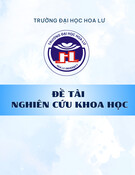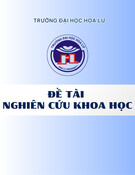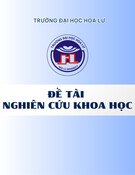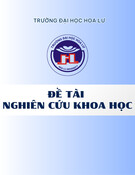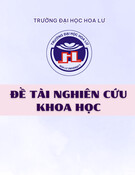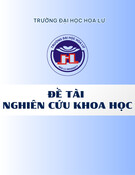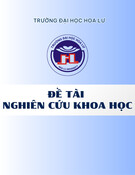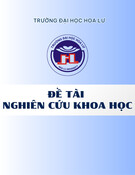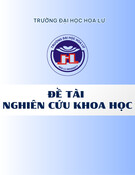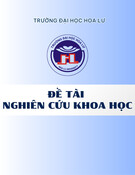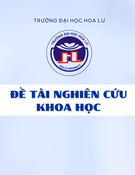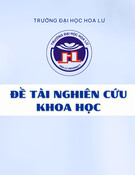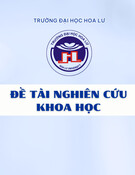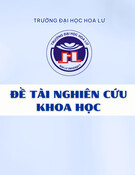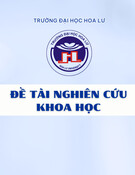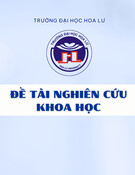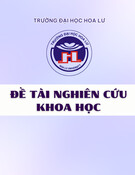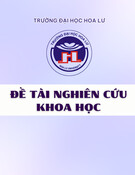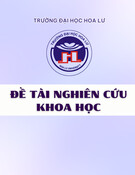
RESEARCH Open Access
The evolution of rectal and urinary toxicity and
immune response in prostate cancer patients
treated with two three-dimensional conformal
radiotherapy techniques
Jana Vranova
1,4
, Stepan Vinakurau
2
, Jan Richter
3
, Miroslav Starec
1
, Anna Fiserova
3*
and Jozef Rosina
4,1
Abstract
Background: Our research compared whole pelvic (WP) and prostate-only (PO) 3-dimensional conformal
radiotherapy (3DCRT) techniques in terms of the incidence and evolution of acute and late toxicity of the rectum
and urinary bladder, and identified the PTV-parameters influencing these damages and changes in antitumor
immune response.
Methods: We analyzed 197 prostate cancer patients undergoing 3DCRT for gastrointestinal (GI) and genitourinary
(GU) toxicities, and conducted a pilot immunological study including flow cytometry and an NK cell cytotoxicity
assay. Acute and late toxicities were recorded according to the RTOG and the LENT-SOMA scales, respectively.
Univariate and multivariate analyses were conducted for factors associated with toxicity.
Results: In the WP group, an increase of acute rectal toxicity was observed. A higher incidence of late GI/GU
toxicity appeared in the PO group. Only 18 patients (WP-7.76% and PO-11.11%) suffered severe late GI toxicity, and
26 patients (WP-11.21% and PO-16.05%) severe late GU toxicity. In the majority of acute toxicity suffering patients,
the diminution of late GI/GU toxicity to grade 1 or to no toxicity after radiotherapy was observed. The 3DCRT
technique itself, patient age, T stage of TNM classification, surgical intervention, and some dose-volume parameters
emerged as important factors in the probability of developing acute and late GI/GU toxicity. The proportion and
differentiation of NK cells positively correlated during 3DCRT and negatively so after its completion with dose-
volumes of the rectum and urinary bladder. T and NKT cells were down-regulated throughout the whole period.
We found a negative correlation between leukocyte numbers and bone marrow irradiated by 44-54 Gy and a
positive one for NK cell proportion and doses of 5-25 Gy. The acute GU, late GU, and GI toxicities up-regulated the
T cell (CTL) numbers and NK cytotoxicity.
Conclusion: Our study demonstrates the association of acute and late damage of the urinary bladder and rectum,
with clinical and treatment related factors. The 3DCRT itself does not induce the late GI or GU toxicity and rather
reduces the risk of transition from acute to late toxicity. We have described for the first time the correlation
between organs at risk, dose-volume parameters, and the immunological profile.
Keywords: 3-dimensional conformal radiotherapy (3DCRT), gastrointestinal and genitourinary toxicity, prostate can-
cer, NK cells, PTV parameters, pelvic bone marrow
* Correspondence: fiserova@biomed.cas.cz
3
Department of Immunology and Gnotobiology, Institute of Microbiology,
Academy of Sciences of the Czech Republic, v.v.i., Prague, Czech Republic
Full list of author information is available at the end of the article
Vranova et al.Radiation Oncology 2011, 6:87
http://www.ro-journal.com/content/6/1/87
© 2011 Vranova et al; licensee BioMed Central Ltd. This is an Open Access article distributed under the terms of the Creative Commons
Attribution License (http://creativecommons.org/licenses/by/2.0), which permits unrestricted use, distribution, and reproduction in
any medium, provided the original work is properly cited.

Background
Quality of life is becoming one of the most significant
issues in treatment decision-making, in general, and
more so in prostate cancer [1]. Thus late rectal and
urinary damage became a major concern in prostate
cancer; and many studies have been dedicated to the
search for correlations between dose-volume, treatment-
related factors, and late GI and GU toxicities [2-7].
Three-dimensional conformal radiotherapy (3DCRT)
represents one of the standard treatments of prostate
cancer allowing the delivery of highly “conformed”
(focused) radiation to the cancer cells, while significantly
reducing the amount of radiation received by surround-
ing healthy tissue. 3DCRT should increase the rate of
tumor control, while also decreasing side effects. In
spite of this focus, a higher dose to the prostate implies
that the surrounding organs at risk (OARs) may also
receive higher doses.
In addition, local radiation therapy (RT) alters the bal-
ance of circulating immune cells by the depletion of radio-
sensitive cell subsets [8]. Recently, radiation-induced
functional changes in immune cells raised interest, sug-
gesting the possible use of radiation as an antitumor
immune response enhancer. Irradiation can induce leuko-
penia due to apoptosis of various leukocyte subpopula-
tions. The acute exposure to low- and high-dose
irradiation in mouse models changes the quantitative and
functional parameters of immune cells, due to different
sensitivity of splenocyte subsets to radiation doses [9].
Similar effect was described in vitro for cervical cancer
patients [10]. Tabi et al. reported a prevalent loss of naive
and early memory cells vs. more differentiated T cells in
peripheral blood of patients during RT to the pelvis [11].
The release of the heat shock protein 72 (HSP72) during
RT increased the cytotoxic CTL and NK cells [12]. Some
pathological changes can be caused by the apoptosis of
bone marrow (BM) stem cells and BM stromal damage
[13]. Radiation-induced BM injury depends on both the
radiation dose and the volume of BM irradiated [14].
We performed a prospective 4-year study, enrolling
prostate cancer patients to elucidate whether the risk
level of acute and particularly late rectal and urinary
toxicities caused by 3DCRT techniques (whole pelvic
(WP) and prostate-only (PO)), are at an acceptable level.
This study reports our 42-month follow-up results, and
evaluates the relationships between pretreatment, acute
and late rectal and urinary syndromes and tumor-,
patient- and treatment-related factors. In the last 3 years
of the study, we investigated the influence of 3DCRT
techniques, as well as the GI and GU toxicity on
selected patient immune parameters, with special regard
to the cells involved in antitumor immunity (natural
killer-NK, NKT, and T).
Methods
Patients and clinical protocol
Data for the study were collected from 245 consecutive
patients with Stage T1 to T3 clinically localized prostate
adenocarcinoma, treated with 3DCRT (2004-2009) at
the Department of Radiotherapy and Oncology, Motol
University Hospital, Prague, Czech Republic. 48 patients
with follow-up shorter than 24 months were excluded
from the study. The study population thus consisted of
197 patients. Patients according to their health and
lymph nodal status (classified by Prostate cancer staging
nomograms-Partin tables) [15] were divided into two
groups: those who underwent whole pelvic (WP) radio-
therapy-irradiation of prostate, seminal vesicles, and
lymph nodes followed by a prostate boost (116 patients,
59%); and prostate-only (PO) radiotherapy-irradiation of
prostate and seminal vesicles (81 patients, 41%). Follow-
up evaluations after treatment were performed at 3 to 6
month intervals. The median follow-up was 42 months,
ranging from 24 to 55 months. Main patient characteris-
tics and main disorders are summarized in Table 1.
Acute and late GI and GU toxicities were studied in
order to identify the treatment-related, clinical and
patient characteristics that correlated with the severity
of complications and disorders. Acute reactions included
those arising during treatment or within 90 days after
RT completion. Late complications were defined as
those developing more than 90 days after the last treat-
ment. Acute and late toxicities were scored according to
RTOG and LENT-SOMA morbidity scale (grades 1-5).
Into the category of low toxicities were encompassed
the patients without the need of pharmacological inter-
vention (grade 1), while the serious toxicity (grade ≥2)
was under medication. In 37 cases (WP: n = 16; PO: n
= 21) the immune response before treatment, during
3DCRT (day 14), and 15-20 days after treatment com-
pletion was evaluated. The protocol was approved by
the local board ethics committee; and written informed
consent was obtained from all patients.
Irradiation technique, target volume and critical normal
structure definition
Treatment planning and irradiation were performed
with the patients in supine position (using knee and
ankle supports) with an emptied rectum and “comforta-
bly full”bladder filling. 3D conformal treatment plan-
ning based on CT images with 5 mm thickness,
involved delineation of CTVs, PTVs and organs at risk,
accordingtoICRU50and62recommendations.The
plans, using MLC to shape beams, were calculated on
Eclipse treatment planning system. Box technique or
four wedged field technique (two lateral and two oblique
fields at angles of 90°, 270°, 30° and 330°) was used. The
Vranova et al.Radiation Oncology 2011, 6:87
http://www.ro-journal.com/content/6/1/87
Page 2 of 13

dose was normalized to the ICRU reference point,
located in the central part of the PTV or near the cen-
tral axis of the beam intersection, according to ICRU
50. Dose homogeneity was between 95% and 107% of
the ICRU reference dose. Dose-volume histograms were
used for evaluation of doses to target volumes and
organs at risk. DRRs were generated for all treatment
beams and for two extra setup beams from the antero-
posterior (AP) and the lateral directions (LAT).
Before the radiotherapy, the treatment plans were
simulated on a conventional simulator (Ximatron and
Acuity
®
, Varian Medical Systems). The isocenter was
marked on the patient’s skin. Patients were irradiated on
a Clinac 2100 C/D (Varian) equipped with Millenium
MLC-120 with beams of 18 MV or 6 MV. The dose was
delivered in daily fractions of 1.8 Gy to the pelvis and of
2 Gy to the prostate and seminal vesicles, in given per-
iod five sessions per week. In the treatment room, the
patients were aligned on a carbon-fiber couch panel
within their immobilization device using the skin marks.
Before the therapy, patient set-up was checked using
electronic portal imaging (PortalVision PV-aS500
®
).
Simulator images of setup fields were used as reference
images for matching with portal images. Planning target
volume (PTV) of the prostate (PTV3) was the entire
organ (clinical target volume of prostate-CTV3), and
PTV2 was the entire prostate and seminal vesicles
(CTV2). Both PTVs were enlarged by 1.5 cm margin,
except for the prostate-rectum interface where a 1 cm
margin was again used to decrease the risk of rectal
toxicity. PTV1 in the WP Group was only the CTV of
lymph nodes (LNs). LNs were defined according to
RTOG recommendations (treatment of only subaortic
presacral LNs, contours of common iliac vessels starting
at the L5/S1 interspace, external iliac contours stopping
at the top of femoral heads, and contours of obturator
LNs stopping at the top of the symphysis pubis) plus a
1 cm margin.
Patients from the PO group received a dose of 60 Gy
in 30 fractions to the PTV2. Then the PTV3 received
the prescribed dose of 10-18 Gy in 5-9 fractions.
Patients from the WP group received a dose of 45 Gy in
25fractionstothePTV1,thenadoseof20Gyin10
fractions to the PTV2. Finally the PTV3 received the
prescribed dose 6-10 Gy in 3-5fractions.Dosevolume
histograms (DVH) were generated for all PTVs and
OARs. The OARs included the bladder, rectum, bone
marrow, and femoral head.
Pelvic bone marrow definition
For each patient, the pelvic bone marrow (PBM) volume
was first defined according to the method described by
Mell et al. [16]. The external contour of the PBM was
delineated on the planning CT using bone windows.
Three sub sites were defined: 1) iliac BM (IBM), extend-
ing from the iliac crests to the superior border of the
femoral head; 2) lower pelvis (LP), consisting of the
pubes, ischia, acetabula, and proximal femora, extending
from the superior border of the femoral heads to the
inferior border of the ischial tuberosities; and 3) lumbo-
sacral spine (LS), extending from the superior border of
Table 1 Patient characteristics
Characteristics WP (n = 116) PO (n = 81)
Age
Median 73 74
Range 57-100 57-92
Mean ± SD 72.93 ± 8.55 74.88 ± 7.79
TNM Stage
T0 1 (0.86%) -
T1 6 (5.17%) 22 (27.16%)
T2 34 (29.31%) 30 (37.04%)
T3 62 (53.44%) 15 (18.52%)
T4 4 (3.45%) 1 (1.24%)
Metastases 2 (1.72%) -
Gleason score
Median 7 5
Range 2-9 3-10
Initial PSA [ng/mL]
Median 19 10
Range 2-133 1-97
Mean ± SD 31.00 ± 8.67 12.46 ± 2.34
ADT 93 (80.07%) 33 (40.74%)
Previous surgery
RP 23 (19.83%) 22 (27.16%)
TURP 7 (6.03%) 5 (6.17%)
Therapy duration (m)
Median 57 54
Range 33-81 22-80
Mean ± SD 57.50 ± 5.56 54.04 ± 7.03
Recurrence Risk*
Low 1 (0.86%) 19 (23.46%)
Intermediate 20 (17.24%) 38 (46.91%)
High 94 (81.03%) 23 (28.40%)
Prescription dose (Gy)
≤71 60 (51.72%) 6 (7.41%)
72, 73 53 (45.69%) 72 (88.89%)
≥74 3 (2.59%) 3 (3.70%)
Disorders
Without complications 49 (42.24%) 37 (45.86%)
Cystoureteritis 16 (13.79%) 15 (18.52%)
Cystoureteritis + diarrhea 15 (12.93%) 1 (1.23%)
Proctocolitis + diarrhea 28 (24.14%) 14 (17.28%)
Unknown 8 (6.69%) 14 (17.28%)
*Recurrence risk was determined according to Canadian Consensus (Lukka
2002): low risk (T1-2a, Gleason ≤6, PSA < 10 ng/mL), intermediate risk (T2b-
2c, Gleason = 7, PSA 10-20 ng/mL), high risk (T3-4, Gleason ≥8, PSA > 20 ng/
mL)
Vranova et al.Radiation Oncology 2011, 6:87
http://www.ro-journal.com/content/6/1/87
Page 3 of 13

the L5 vertebral body to the coccyx, but not extending
below the superior border of the femoral head. To find
the association of local radiation doses and changes in
the number of leukocytes among patients with different
body sizes, the percentage of BM irradiated volume at
different doses was used as a first approximation.
Cell separation for immunological evaluations
Citrated blood samples from patients were separated by
Ficoll-Hypaque 1,077 (Sigma-Aldrich, St. Louis, MO,
USA) density centrifugation for 40 min to obtain the
peripheral blood mononuclear cell (PBMC) fraction.
Flow cytometry
The fluorochrome-conjugated antibodies CD3-Pacific
Blue (UCHT1), CD4-APC-Alexa Fluor 750 (S3.5), CD8-
Pacific Orange (3B5) CD19-Pacific Blue (HD37), CD20-
PE-Cy7 (2H7), CD38-PerCP-Cy5.5 (HIT2), and CD56-
APC (MEM-188), were obtained from Dako (Glostrup,
Denmark), Exbio (Prague, Czech Republic), BD Bios-
ciences (Franklin Lakes, NJ, USA), and e-Bioscience
(San Diego, CA, USA). PBMCs (5 × 10
5
cells/well) were
stained with the antibody mixture for 30 min on ice,
washed, and measured with a Becton Dickinson LSRII
instrument (BD Biosciences). We included single-stain
controls for further offline compensation. Measurement
and subsequent analysis was performed using FACSDiva
(BD Biosciences) and TreeStar FlowJo 8 (Ashland, OR,
USA) software, respectively.
NK cell-mediated cytotoxicity
The standard
51
Cr-release assay was performed with
PBMCs from patients as effectors and the NK cell-sensi-
tive K562 erythroleukemia cell line as targets. PBMC
(1.6 × 10
5
cells/well) were incubated with 10
4
Na
251
CrO
4
-labeled target cells in round-bottomed 96-
well microtitre plates (NUNC) at 37°C, in a humidified
atmosphere containing 5% CO
2
. NK cell activity was
evaluated after 4 hr of incubation, and calculated as
described previously [17].
Statistical analysis
We investigated all GI and GU toxicities (late and acute)
separately. There were only 3 cases of grade 3 acute GI
toxicity, only 5 cases of grade 3 acute GU toxicity, and
none of grade 4 or 5. Similar observation was made for
late GI toxicity (only 5 cases of grade 3, 1 of grade 4, and
no instances of grade 5) and for late GU toxicity (only 13
patients of grade 3 and none of grade 4 or 5). As a conse-
quence, we grouped the toxicity levels of all diagnosed
toxicities (acute GI, acute GU, late GI, and late GU) in
two categories and analyzed the binary response. The
grouping of responses considered was: high toxicity
(grade 2-3) vs. low or no toxicity (grades 1 or 0).
The grouped data were analyzed using multivariate
logistic regression models. The list of predictive factors
was the same for acute and late toxicities; except for the
addition of acute toxicity, as the next predictive factor
of late OAR damage. The patient-, tumor-, and treat-
ment-related factors were as follows: 3DCRT technique
used (WP vs. PO); volumes of rectum and urinary blad-
der; minimum, maximum, and mean dose received by
the rectum and urinary bladder (D
min
,D
max
,D
mean
);
percentage of rectum and urinary bladder volume
receiving 40 Gy, 50 Gy, 60 Gy, and 70 Gy, respectively;
patient age; stage T of TNM classification; initial PSA;
Gleason score; androgen deprivation therapy (ADT)
added to RT (yes/no); surgical intervention (None/
Transurethral resection/Radical prostatectomy) of the
prostate (NONE/TURP/RP); occurrence of hemorrhoids
(yes/no); and duration of RT (weeks). A Pearson’sc
2
test or, in the case of small sample size, Fisher’sexact
test was used to examine whether there was a statisti-
cally significant difference in the occurrence and evolu-
tion of acute and particularly late GU and GI toxicity
between the two observed 3DCRT techniques.
To evaluate the association of immune response and
toxicity level, the patients were divided in the group T
(patients with any toxicity level-grades 1-3) and group 0,
those with no toxicity (grade 0). To compare the
immune parameters between these groups of patients
the t-test was performed. To find the relationship
between immune response in prostate cancer patients
and treatment related factors, Pearson’s correlation coef-
ficients were calculated.
For statistical analysis Statsoft’s STATISTICA version
9 and SPSS Statistics version 18 were used. All tests
were considered to be statistically significant at the level
of p < 0.05. The required sample size for all performed
statistical tests was calculated using IBM SPSS Sample-
Power software version 3.
Results
Logistic regression models for GI and GU toxicities
Four logistic regression models for acute GI, acute GU,
late GI, and late GU toxicity were created. All models
were statistically significant and adequately interpolated
the data; however in both models for late toxicities, GI
and GU, a large disparity between the number of
patients in groups with high toxicity vs. low or no toxi-
city was observed. The classification ability of all four
models was very good-80.0% for acute GI toxicity, 78.9%
for acute GU toxicity, 76.3% for late GI toxicity, and
76.0% for late GU toxicity. The area under the ROC
curve (AUC) which determines the discrimination
power of the logistic model reached the following
values: 0.836 for acute GI toxicity-discrimination quality
according to Tape [18], “Good"; 0.810 for acute GU
Vranova et al.Radiation Oncology 2011, 6:87
http://www.ro-journal.com/content/6/1/87
Page 4 of 13

toxicity-"Good"; 0.784 for late GI-"Fair"; and 0.761 for
late GU toxicity-"Fair”.
The significance level and odds ratio for statistically
significant regression coefficients are summarized in
Table 2 for acute and late GI and GU toxicity. Acute GI
and GU toxicities were significantly dependent on
patients’increasing age, and the chance of developing
high toxicity levels greaten. For late GI and GU toxici-
ties, the larger irradiated volume of OARs (rectum and
urinary bladder) enhanced the chance of high-level toxi-
city occurrence. Other important predictors of acute GI
toxicity were the percentage of rectum volume receiving
70 Gy (the higher the percentage of rectum, the higher
the chance of high level toxicity) and the 3DCRT tech-
nique used, where the high-level toxicity developed
when the WP technique was used (26.16 times greater
than in the case of the PO technique). The higher T
stage of TNM classification and the acute GI toxicity
significantly increased the probability of late GI toxicity
occurrence. The results pointed to the significant asso-
ciation of acute GU toxicity and the percentage of the
urinary bladder receiving 50 Gy, and the association of
late GU toxicity with the percentage of the urinary blad-
der receiving 40 Gy. Both types of urinary toxicities
(acute and late) were augmented by radical prostatect-
omy prior to radiotherapy (NONE vs. RP) that increased
the occurrence of high-level toxicity for acute and late
GU toxicity 7.35 times (OR = 0.136) and 11.15 times
(OR = 0.090), respectively. Another important statisti-
cally significant predictor found for late GU toxicity was
the PO type of 3DCRT that evoked the development of
high-level toxicity 1.72 times more (OR = 0.580) in
comparison with WP technique.
GI and GU toxicity evolution after WP and PO 3DCRT
techniques
The used 3DCRT technique was proven as an important
factor influencing the development of GI and GU toxi-
city. Consequently, we analyzed the occurrence and evo-
lution of late GI and GU toxicity from pretreatment
symptoms through acute GI and GU toxicity in each
group of patients separately. The proportion of patients
suffering pretreatment GU, as well as GI pathologies,
was comparable in the groups undergoing either the
WP or PO 3DCRT therapy. The proportion of GU toxi-
city did not change significantly between the WP and
PO techniques in all appearing grades (0-3). The results
of toxicity dynamics are summarized in Table 3. The
values of the last late GI and GU toxicity observed in
patients during their last inspection are shown.
In the cohort of patients included in the WP group,
pretreatment GI toxicity of grade 2 was found in the
history of 2 patients (1.72%), and only 1 patient (0.86%)
showed grade 3. During treatment or within the first 90
days after treatment, acute grade 2 GI toxicity occurred
in 65 (56.03%) and grade 3 GI toxicity in 3 patients
(2.59%).TheseverelateGItoxicityofgrade2occurred
in 5 (4.31%), grade 3 in 3 patients (2.59%), and grade 4
in 1 patient (0.86%). There were no late grade 5 GI toxi-
city-suffering patients in this group. Pretreatment GU
damage of grade 2 was found in the history of 4 patients
(3.44%) and grade 3 in the history of 2 patients (1.72%).
WP 3DCRT evoked acute grade 2 GU toxicity in 30
(37.04%) and acute grade 3 GU toxicity in 4 patients
(3.45%). Severe late GU toxicity of grade 2 occurred in 8
patients (5.76%) and grade 3 in 6 patients (7.41%).
There were no late grade 4 or 5 GU toxicities observed.
Table 2 Logistic regression models for acute and late GI and GU toxicities.
Acute GI toxicity Late GI toxicity
Variable OR 95% CI p Variable OR 95% CI p
Age 1.097 1.03-1.17 0.006 Volume of rectum 1.028 1.00-1.06 0.036
Percentage of rectum receiving
70 Gy
1.134 1.03-1.25 0.009 T stage of TNM classification 4.630 1.09-20.00 0.037
3DCRT technique
WP vs PO
26.163 5.10 -134.2 0.000 Acute GI
Low vs High
0.115 0.01-0.92 0.042
Acute GU toxicity Late GU toxicity
Variable OR 95% CI p Variable OR 95% CI p
Age 1.108* 1.02-1.20 0.015 Volume of urinary bladder 1.016 1.00-1.03 0.018
Percentage of urinary bladder receiving
50 Gy
1.127 1.01-1.25 0.026 Percentage of urinary bladder receiving
40 Gy
1.144 1.00-1.30 0.045
Surgical intervention
None vs RP
0.161 0.04-0.68 0.013 Surgical intervention
None vs RP
0.089 0.01-0.85 0.035
3DCRT technique
WP vs PO
0.580 0.10-1.74 0.029
Odds ratios (OR), 95% Confidence Intervals (CI) and significance levels (p) of Wald chi-square statistic of patient-, tumor-, and treatment-related factors that meet
statistical significance are presented
Vranova et al.Radiation Oncology 2011, 6:87
http://www.ro-journal.com/content/6/1/87
Page 5 of 13

